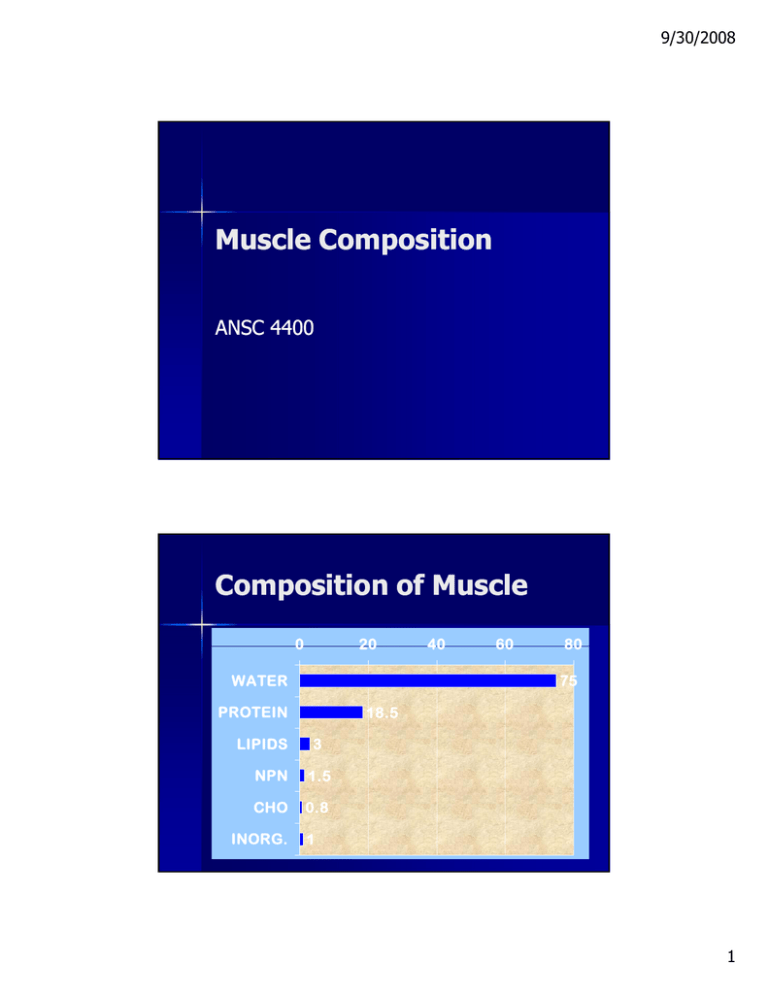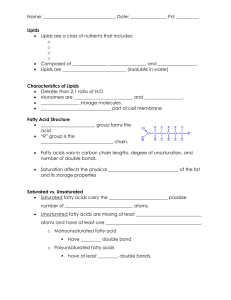M scle Composition Muscle Composition Composition of Muscle
advertisement

9/30/2008 M scle Composition Muscle ANSC 4400 Composition of Muscle 0 20 WATER 80 18.5 3 NPN 1.5 CHO 0.8 INORG. 60 75 PROTEIN LIPIDS 40 1 1 9/30/2008 Water Varies inversely with fat content – Muscles with more fat contain less water – Typical range = 65 to 80 percent • Carrier of intraintra- and interinter-cellular constituents Protein Averages 18 18.5% 5% in muscle Is least variable component Is the most important component Is the food component in shortest supply in food supply (world) 2 9/30/2008 Protein Composed of amino acids with following basic structure: Amino Acids 3 9/30/2008 Types of Protein Myofibrillar – 9.5% 9 5% – Myosin and actin Sarcoplasmic – 6% – Enzymes and pigments – Mb and Hb – Functional roles – Globular Myoglobin 4 9/30/2008 Types of Proteins Stromal – 3% – Connective tissues – Collagen, elastin, reticulin Collagen – Most M t abundant b d t protein t i in i body b d – Increase age, what happens? – Degrades to gelatin at 65 degrees C Types of Proteins Elastin – Does not degrade to gelatin – Example is ligamentum nuchae – Imparts elasticity in arterial walls 5 9/30/2008 Lipids – Fats and Oils Influence flavor flavor, juiciness juiciness, and calorie content Averages 3% in muscle Cattle with higher marbling scores = higher or lower fat content? Kinds of Lipids NEUTRAL LIPIDS - 1% PHOSPHOLIPIDS - 1% CHOLESTEROL - 0.5% 6 9/30/2008 NEUTRAL LIPIDS Tryglycerides = 3 mole of fatty acid attached to a glycerol CH2OH C(CH2)16CH3 l CHOH + 3 HOOC(CH2)16CH3 H2O l CH2OH GLYCEROL + STEARIC ACID H2C-Ol HC--O-C-R + 3 HC l H2C-O-C-R TRISTEARIN KINDS OF TRIGLYCERIDES If the same kind of fatty acid occupies all three positions on the glycerol molecule, the result is a simple triglyceride. If more than one kind of fatty acid is attached to glycerol, the result is a mixed triglyceride. What determines what kinds of tri tri-- glycerides an animal manufactures? 7 9/30/2008 SATURATED FATTY ACIDS Stearic Acid – Saturated Fatty Acid No double bonds between carbon atoms Third most predominant FA in meat animals UNSATURATED FATTY ACIDS OLEIC ACID : The most prevalent fatty acid in animal fats Mono-saturate fatty acid (contains one double bond) 8 9/30/2008 Polyunsaturated Fatty Acids Linoleic Acid – Polyunsaturate y fattyy acid – Has two (or more) double bonds Reactivity of Fatty Acids Unsaturated fatty acids are more reactive O2 attaches at double bonds – Results in rancidity and oxidation 9 9/30/2008 Melting Points of Some Fats WHY THE RANGES AND SPECIES DIFFERENCES? In General: Fats with longer carbon chains and more saturation have higher melting points. Internal fats are more saturated and have higher melting points than external fats Why? What practical difference does melting point of fats per se make in animal bodies and in industry? 10 9/30/2008 The Third Kind of Lipids Phospholipids osp o p ds - co compounds pou ds containing co ta g phosphorus p osp o us and a d lipids An example is ethanolamine Function in rancidity development in fats. The Fourth Kind of Lipids Cholesterol C o este o - tthat at much uc maligned, a g ed, essential esse t a dietary d eta y component. Required for hormone function and cell wall integrity. About 20% of body needs is consumed whereas, 80% is manufactured. If we don’t eat enough, our bodies manufacture more. Contrary to popular belief, cooked meats of different species vary little in cholesterol content. 11 9/30/2008 NPN – Non - Protein Nitrogen About 1.5% 1 5% in muscle Molecules contain nitrogen but are not proteins Some NPN compounds contribute to meat flavor NPN example – ATP (Adenosine triphophate) CHO - Carbohydrates About 1% ((0.8%)) found in muscle – ranges from 0.5 - 1.5% in muscle. Although low in amount, CHO’s play large roles in meat properties and appearance. B t example Best l is i Glycogen Gl – storage form composed of glucose units 12 9/30/2008 Inorganic Compounds - Minerals About 1% in muscle Measured as ash after burning samples in a muffle furnace Meat (particularly beef) is a good source of some minerals, particularly Fe and Zn. F iin meatt is Fe i in i a heme h form f that th t is i more readily dil available il bl than th fe f from plants. Zn is in many enzymes and hormones, including sex hormones. Individual Compositional Components Carcass Muscle Fat Bone 13 9/30/2008 Chemical components percentage 600 Water Fat Protein Ash 500 T is s u e W e ig h t 400 300 200 100 0 1 2 3 4 5 6 7 8 Body Weight 100 Bone Fat % Muscle 0 Carcass Weight 14 9/30/2008 Fat Partitioning 1 1. 2. 3. 4. 5 5. Mesenteric KPH Intermuscular Subcutaneous Intramuscular Measuring Carcass Composition Direct Method – Ideal reference endpoint – where there are no limitations on cost, time, labor Chemical analyses of carcass tissues – Predictors – depend on objectives and resources Biological – whole body chemical comp Economical – Edible product, saleable product, etc 15 9/30/2008 Measuring Carcass Composition Indirect Method – Linear measurements – Specific gravity – Ultasound – Probes Thermistor – temp Ulster – color Danish meatmeat-fat automatic probe – electrical Hennessy Probe – fat depth Muscle Fiber Types 16 9/30/2008 Book Reading Pages 36 – 43 Table 2.2 Table 2.3 17






